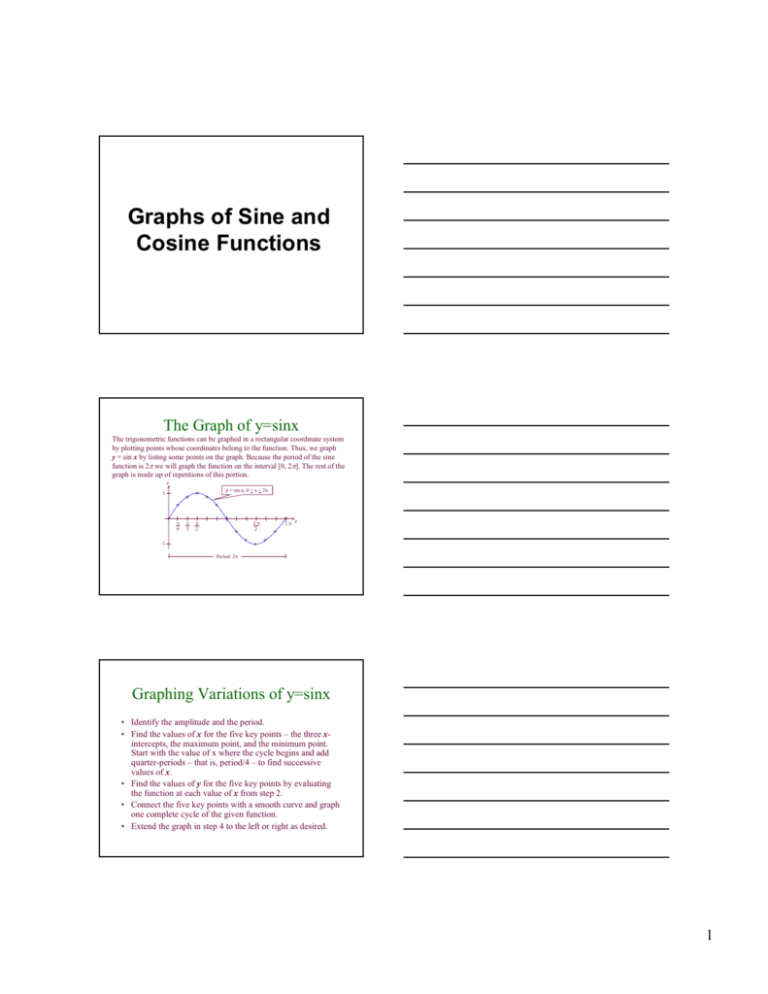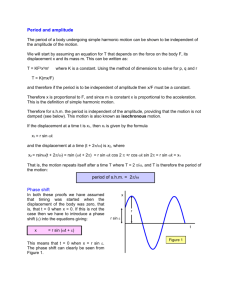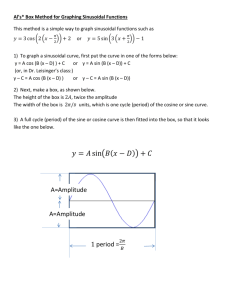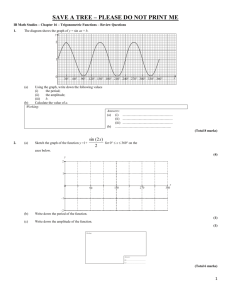Graphs of Sine and Cosine Functions
advertisement

Graphs of Sine and Cosine Functions The Graph of y=sinx The trigonometric functions can be graphed in a rectangular coordinate system by plotting points whose coordinates belong to the function. Thus, we graph y = sin x by listing some points on the graph. Because the period of the sine function is 2π we will graph the function on the interval [0, 2π]. The rest of the graph is made up of repetitions of this portion. y y = sin x, 0 < x < 2π 1 π 6 π 3 π 2 ˝ 3π 2 2π x -1 Period: 2π Graphing Variations of y=sinx • Identify the amplitude and the period. • Find the values of x for the five key points – the three xintercepts, the maximum point, and the minimum point. Start with the value of x where the cycle begins and add quarter-periods – that is, period/4 – to find successive values of x. • Find the values of y for the five key points by evaluating the function at each value of x from step 2. • Connect the five key points with a smooth curve and graph one complete cycle of the given function. • Extend the graph in step 4 to the left or right as desired. 1 Text Example Determine the amplitude of y = 1/2 sin x. Then graph y = sin x and y = 1/2 sin x for 0 < x < 2π. Solution Step 1 Identify the amplitude and the period. The equation y = 1/2 sin x is of the form y = A sin x with A = 1/2. Thus, the amplitude |A| = 1/2. This means that the maximum value of y is 1/2 and the minimum value of y is -1/2. The period for both y = 1/2 sin x and y = sin x is 2π. Text Example cont. Solution Step 2 Find the values of x for the five key points. We need to find the three x-intercepts, the maximum point, and the minimum point on the interval [0, 2π]. To do so, we begin by dividing the period, 2π, by 4. Period/4 = 2 π/4 = π/2 We start with the value of x where the cycle begins: x = 0. Now we add quarter periods, π /2, to generate x-values for each of the key points. The five x-values are x = 0, x = 0 + π/2 = π/2, x = π/2 + π/2 = π, x = π + π/2 = 3 π/2, x= 3 π/2 + π/2 = 2 π Text Example cont. Solution Step 3 Find the values of y for the five key points. We evaluate the function at each value of x from step 2. y = 1/2 sin0 = 0 y = 1/2sinπ/2 = 1/2*1 = 1/2 y = 1/2sinπ = 1/2*0 = 0 y = 1/2 sin 3π/2 = 1/2(-1) = -1/2 y = 1/2sin2π = 1/2*0 = 0 (0,0) (π/2, 1/2) (π,0) (3 π/2, -1/2) (2π, 0) There are x-intercepts at 0, π and 2 π. The maximum and minimum points are (π/2, 1/2) and (3 π/2, -1/2) 2 Text Example cont. Solution Step 4 Connect the five key points with a smooth curve and graph one complete cycle of the given function. The five key points for y = 1/2sin x are shown below. By connecting the points with a smooth curve, the figure shows one complete cycle of y = 1/2sin x. Also shown is graph of y = sin x. The graph of y = 1/2sin x shrinks the graph of y = sin x. y y = sin x 1 y = 1/2sinx 2˝ x ˝ -1 Amplitudes and Periods The graph of y = A sin Bx has amplitude = | A| period = 2π /B. y y = A sin Bx x Amplitude: | A| Period: 2π /B The Graph of y = Asin(Bx - C) The The graph graph of of yy == A A sin sin (Bx (Bx –– C) C) is is obtained obtained by by horizontally horizontally shifting shifting the the graph graph of of yy == A A sin sin Bx Bx so so that that the the starting starting point point of of the the cycle cycle is is shifted shifted from from xx == 00 to to xx == CC//BB.. The The number number CC//BB is is called called the the phase phase shift. shift. y amplitude amplitude == || A| A| period period == 2π //BB.. y = A sin Bx Amplitude: | A| x Starting point: x = C/B Period: 2π/B 3 Example Determine the amplitude, period, and phase shift of y = 2sin(3x-π) Solution: Amplitude = |A| = 2 period = 2π/B = 2π/3 phase shift = C/B = π/3 Example cont. • y = 2sin(3x- π) 3 2 1 -6 -5 -4 -3 -2 -1 1 2 3 4 5 6 -1 -2 -3 The Graph of y = AcosBx We graph y = cos x by listing some points on the graph. Because the period of the cosine function is 2π, we will concentrate on the graph of the basic cosine curve on the interval [0, 2 π]. The rest of the graph is made up of repetitions of this portion. . y 1 -3π /2 -π -π/2 π/2 π 3π/2 2π 5π/2 x -1 Period: 2π 4 The Graph of y = AcosBx The The graph graph of of yy == A A cos cos Bx Bx has has amplitude amplitude == || A| A| period = 2π/B. period = 2π/B. y y = A cos Bx Amplitude: | A| x 2π/B Period: 2π/B The Graph of y = Acos(Bx - C) The The graph graph of of yy == A A cos cos (Bx (Bx –– C) C) is is obtained obtained by by horizontally horizontally shifting shifting the the graph graph of of yy == A A cos cos Bx Bx so so that that the the starting starting point point of of the the cycle cycle is is shifted shifted from from xx == 00 to to C C xx == CC//BB.. The number / B is called the phase shift. The number /B is called the phase shift. y = A cos( Bx-C) y amplitude = | A| amplitude = | A| period period == 2π //BB.. Amplitude: | A| x Period: 2π/B Graphs of Sine and Cosine Functions 5







